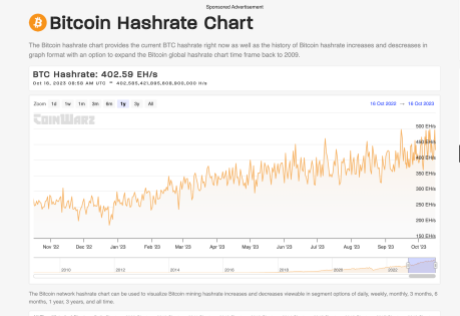As analysts keep debating the future of the flagship cryptocurrency, Bitcoin, the hashrate of the network has seen exponential growth, with this key indicator about to experience a 100% increase (year-to-date) before the year is out.
How Bitcoin’s hashrate has grown
The hashrate, which is used to measure computing power used to mine and process transactions on the network, currently (at the time of writing) stands at 445 exahashes per second (EH/s). This figure represents a significant increase, as the network hashrate on January 1, 2023 was 255 EH/s.

Hashrate almost 100% up | Source: CoinWarz
These numbers mean that the network’s hashrate has grown by 190 EH/s since the beginning of the year, and at this rate could reach 510 EH/s by the end of the year, representing a 100% increase compared to the beginning of the year. These numbers suggest that too more miners have jumped on the Bitcoin blockchain, making it faster and more secure.
At this rate, the hashrate could also be on track to fulfill some of analysts’ predictions. In March, research analyst Sam Wouters at River Financial said noted the impressive growth rate and predicted that Bitcoin’s hashrate could reach a “Zettahash” by the end of 2025. A Zettahash corresponds to 1,000 EH/s.
At this current rate, some have noted that Wouters’ prediction could become reality on December 23, 2025, or early 2026.
Despite this significant growth rate, it is worth mentioning Bitcoin hash price has remained rather lukewarm over the same period. Hash price refers to the income generated by miners based on tera hash.
The hash price is currently close to $60, almost the same figure as at the beginning of the year. Notably, Miners’ biggest payday came on May 8, 2023, when the hash price was $125.
Where the Bitcoin hashrate comes from
In his tweet In March, Wouters also tried to analyze where Bitcoin’s hashrate growth could come from. He shared his belief that the added hashrate was unlikely to come from nation states, as some people might suggest. According to him, there is little chance that nation states will provide computing power to the network and remain secret, because “there are far too many people involved in carrying out large-scale operations.”
He concluded by stating that the source of the added hashrate was “nuanced” as it could simply be the result of factors such as new models coming to market, unused inventory going online, more facilities going live and the also entrepreneurs who find cheap sources before regulators intervene.
BTC recovers as mining interest grows | Source: BTCUSD on Tradingview.com
Featured image from Coinmama, chart from Tradingview.com

